on Mercedes (twice), the end of the BMW i3, quality at Ford, three pickups, pricing. . .and even more (whew!)
A big Mercedes investment. . .the end of i3 production by BMW. . .COVID and quality at Ford. . .a pickup from VW. . .a pickup from GMC. . .a pickup from Geely (only the middle one available in the U.S.). . .pricing and supply. . .Camry Hybrid review. . .a Mazda diesel in the U.K.
#workforcedevelopment
This Matters at Mercedes (and Arguably Everywhere Else)

Building the Mercedes EQE in Bremen, Germany. (Image: Mercedes)
Mercedes is making of an investment of more than €1.3 billion by 2030 in Germany alone.
What is that investment in:
- More members of the EQ family of electric vehicles
- A gigafactory to produce batteries
- Employee education
If you guessed the last one, you’re right.
“For a fully electric and digital future as a luxury brand, we have generated a noticeable sense of new beginnings at Mercedes-Benz. Turn2Learn takes this up and puts the qualification for all employees at Mercedes-Benz on a new level. With Turn2Learn we create limitless opportunities for lifelong learning at Mercedes-Benz. Everyone can continue their education independent of time and place, and across all units and levels. As a company, we primarily rely on learning paths that enable us to forge ahead with digitalization and electrification. I am very pleased that Turn2Learn enables colleagues to educate themselves according to their personal interests in order to promote willingness for lifelong learning. In the transformation, lifelong learning is not a buzzword, but the condition for success — for the company and for each individual colleague.”--Sabine Kohleisen, Member of the Board of Management of Mercedes-Benz Group AG, Human Resources & Labour Director.
Yes, education.
The approach
The Turn2Learn program includes e-learning, customized curricula, and other forms of continuing education, digital and physical.
Mercedes is training all employees in basic digital knowledge (including machine learning, IoT and blockchain, which don’t strike me as being particularly basic).
For production employees there is a focus on electric mobility.
Last year Mercedes employees in Germany completed some 1.3 million hours of training.
Those developing and building the future are going to need to be well educated.
Clearly, Mercedes understands that and is doing something about it.
>>>
BMW Says Goodbye to the i3
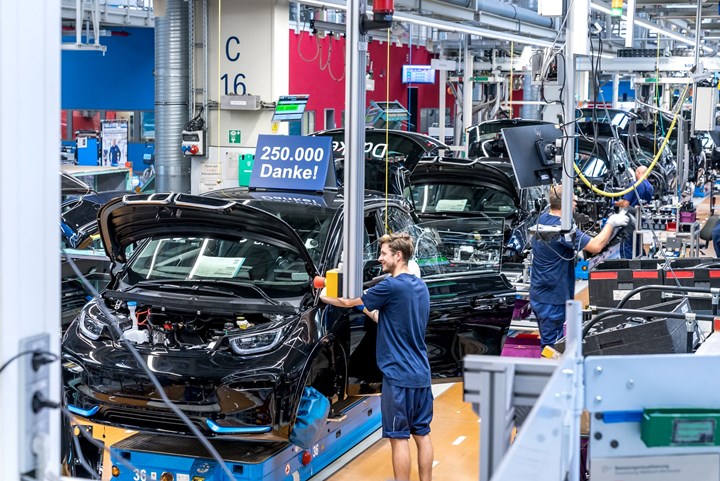
End of the line for the BMW i3 in Leipzig. (Image: BMW)
And while on the subject of electric vehicles in Germany. . .
The BMW Group plant in Leipzig has completed its production of the BMW i3 after eight-and-a-half years.
Oliver Zipse, chairman of the Board of Management of BMW AG, said of the premium compact EV:
“The BMW i3 has great symbolic power.”
There were 250,000 built
The car was sold in some 74 countries.
Early in its availability, 80% of buyers were new to BMW Group products. This tends to be something that marketing people at OEMs boast about regarding their new EVs. A question is how long they stay with the brand. BMW sold 103,855 EVs globally last year and is on track to double that number this year, so looking at the total number of i3s built, clearly there is traction for BMW in EVs.
The modules
One of the most notable aspects of the i3: the modular construction.
There is a “drive module” consisting of an aluminum chassis, e-drive and battery that’s mated with the “life module,” the passenger cell, produced out of carbon fiber-reinforced plastic (CFRP).
BMW had been so big on the promise of carbon fiber that it created a joint venture with SGL Carbon, a materials company, SGL Automotive Carbon Fibers.
In late 2017 SGL Carbon acquired BMW’s 49% equity investment in the firm.
This is not to say that BMW isn’t interested in using CFRP for its vehicles. Just that it decided to spend its money in other undertakings.
Leipzig continues
The Leipzig plant, which was the exclusive producer of the i3, continues to manufacture the BMW 1 Series, the BMW 2 Series Gran Coupé, and the BMW 2 Series Active Tourer. In 2023 the next-generation MINI Countryman—including an EV version—will be built in Leipzig.
>>>
Another COVID Consequence
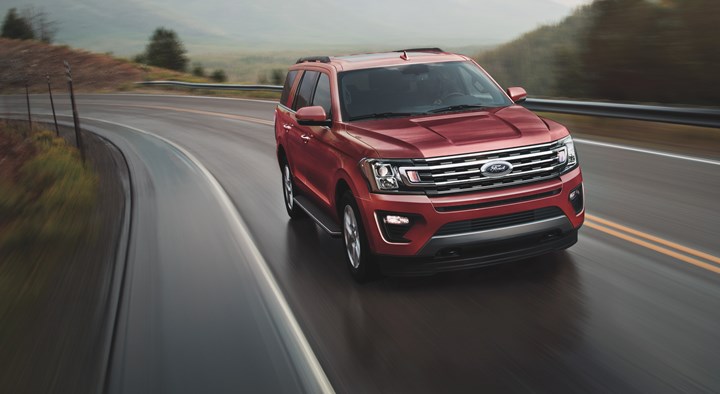
COVID is said to have contributed to a recall that Ford initiated for some Ford Expeditions and Lincoln Navigators. (Image: Ford)
The effects of COVID on initial quality as calculated by J.D. Power was noted in last week’s installment.
And now there’s another reference to the deleterious effects that the virus has had on vehicles, as well.
Ford Motor told owners of 2021 Ford Expedition and Lincoln Navigators to park their vehicles outside and away from structures. . .because of the potential of under hood fires.
It is recalling 66,221 of the SUVs built between July 27, 2020 and August 31, 2021.
The company has identified the cause and developed a fix. It will be getting parts to dealers to make the required changes.
How did this happen?
According to a statement from the company:
“Ford believes the cause of these vehicle fires can be traced to a change in manufacturing location by a supplier during the COVID-19 pandemic. Printed circuit boards produced at this facility are uniquely susceptible to a high-current short and were supplied to Ford and installed in Expedition and Navigator SUVs produced during the recall window.”
Here's hoping that there aren’t other similar issues arising in the months ahead.
>>>
(Not) Coming to America
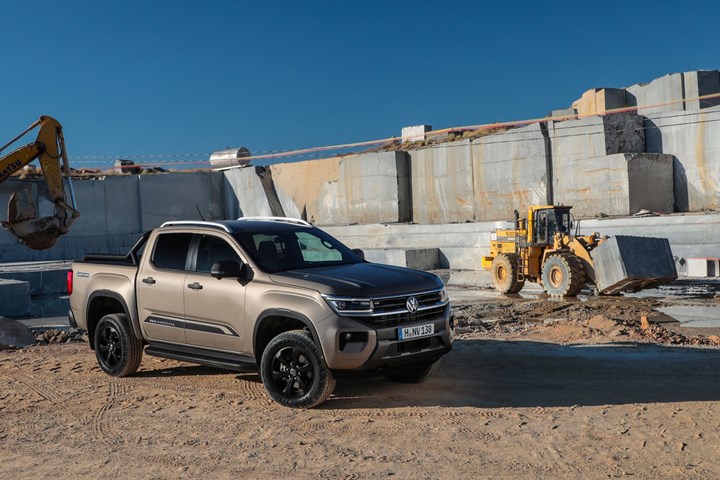
The VW Amarok pickup. A new vehicle that won’t be hitting the U.S. market. (Image: VW)
That picture above of a pickup truck at a worksite is something of a trope for trucks:
Show ‘em that it can get the job done. And then sell trucks that are ladened with the latest tech and the highest levels of comfort, trucks that are likely to show up on the job only by mistake.
While the pickups in such photos are usually from Ford or Ram, that one is from VW.
Specifically: Volkswagen Commercial Vehicles.
It is the new Amarok. The second-generation of the truck.
For those of you (us) in North America: Nope.
The markets for the truck are Europe, Australia, New Zealand, Africa, North Asia, and South and Central America.
It was developed in Germany and Australia. It is being produced in South Africa.
A few things you don’t usually hear about regarding U.S. pickups:
- Pallets. In providing a metric for the sizes of the boxes (the Double Cab has one that is 1,544 mm long and provides 1,206 mm between the wheel arches, or basically five feet long and four feet wide; the Single Cab is 2,305 mm long or about 7.5 feet, with the same width), the Euro pallet is used. The Euro pallet measures 1,200 x 800 mm, or 31.5 x 47.24 inches. Put in sideways, the Double Cab can accommodate one pallet and the Single Cab two.
- Roof capacity. The static roof-load capacity of the Amarok is 350 kg (770 pounds). Why does VW point that out? Because that means it can handle a four-person roof tent (which VW is offering as an accessory). Yes, camping on the roof.
- Four out of five. . .diesels. There are five engines on offer. Four of them are turbodiesels. One is a turbocharged gas engine. The diesels feature three, four or six cylinders and range in output from 110 to 184 kW (148 to 247 hp). The base engine, which is mated to a five-speed manual transmission, was “specially developed for various African markets.” The 2.3-liter gas engine produces 298 hp; it is mated to a 10-speed automatic. There are also manual and automatic six speeds. (In the case of a Chevy Silverado there is either an eight- or 10-speed automatic; an F-150 has a 10-speed; and the Ram 1500 is offered with eights.) It comes with RWD or AWD and there are two AWD variants.
The Amarok comes in five trims: Amarok (base), Life, Style, PanAmericana and Aventura (with the last two being the top trims: the former focused on off-road and the latter comfort).
How many Amaroks with chrome trim on the outside and Savona leather on the inside do you think are going to be parked next to big yellow front loaders. . . ?
>>>
Sierra 1500 AT4X AEV Edition: The Steel Deal
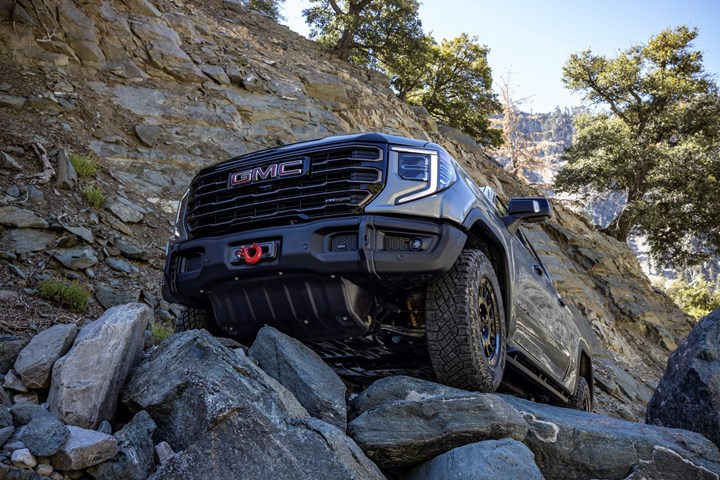
Serious steel for a serious off-road GMC Sierra pickup. (Image: GMC)
And while on the subject of pickups. . .
“Leveraging GMC’s unwavering dedication to providing premium trucks and American Expedition Vehicles’ expertise in engineering and integrating performance-driven parts and accessories, this truck provides extreme capability, technology and comfort,” said GMC Global Vice President Duncan Aldred.
The truck in question is the 2023 Sierra 1500 AT4X AEV Edition.
And AEV’s CEO and founder Dave Harriton chimed in about the truck that was introduced last week and will become available later in the 2023 model year:
“The Sierra 1500 AT4X is an incredibly formidable platform when it comes to on- and off-road performance and capability. We took our signature approach to help elevate this truck’s inherent off-road capability to the next level.”
Why is this interesting?
Features called out on the truck are:
- AEV stamped steel front and rear bumpers that are made from 3-mm steel that are powder and e-coated
and
- Five ultra-high strength, hot-stamped boron steel skid plates. The press-hardened steel is said to be 3.5x stronger than an equivalent cold-stamped high-strength steel component. The plates protect the front approach, steering gear, transfer case, fuel tank and rear diff
Think about it: When is the last time you heard such positive info about steel that didn’t come from the AISI?
>>>
Put This on Your Radar
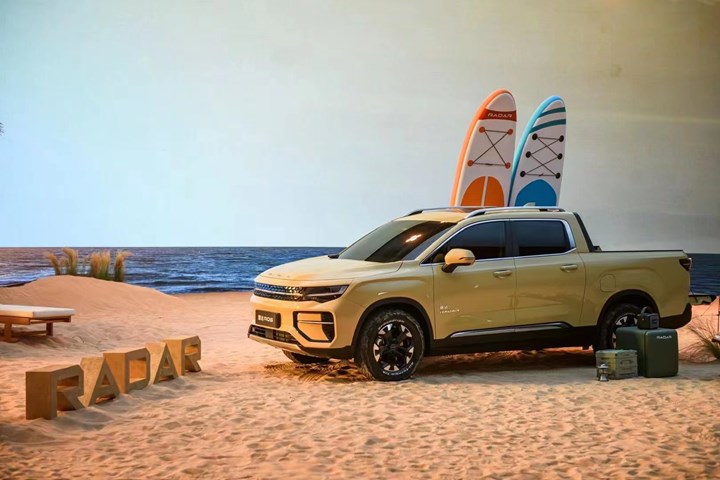
Surf’s up! The Radar RD6 adventure pickup. From China. (Image: Radar Auto)
And still another pickup (after which I’ll stop). . . .
One thing to know about Peter Horbury, who has been instrumental in the development of the design organization for Geely (which encompasses auto brands Geely Auto, Lynk & Co, Proton, Volvo, Polestar, London EV Co., Yuan Cheng Auto, Zeekr, and Lotus (where he is now Senior Vice President, Executive Advisor, Design) and now Radar):
Earlier in his career, in 2004, when he was working in Dearborn, Horbury was named executive design director for all Ford brands in North America (Ford, Lincoln and the still-existing Mercury). Part of his remit as to amp up the “Americanness” of the products. Yes, including the F-150. Horbury knows trucks.
And now this from Horbury:
“The Radar product portfolio is focused on electric pick-up trucks and SUVs, this direction challenges us to mix functionality and usability with aesthetic form. Our aim is to let Radar users expand their horizons and explore nature in a sustainable way.”
Yes, a new brand making electric pickups.
Radar Auto is described as “an independent brand within the wider Geely Holding Group.” It has R&D in Hangzhou and an EV factory in Zibo, Shandong.
While there are no specs available for the first Radar pickup, the RD6, it is based on the Geely-developed Sustainable Experience Architecture, a platform that comes in five variants the company developed for EVs.
Note: While the so-called “Chicken Tax,” a 25% tariff established in 1963 on the imports of light trucks, is likely to prevent Radar products from competing with the likes of the F-150 Lightning, Horbury’s friends in Dearborn have got to be thinking. . . .
>>>
Read This While You’re Sitting Down
“Increasingly higher prices and shrinking inflation-adjusted disposable incomes make major purchases less affordable for the U.S. consumer. Moreover, rapidly rising interest rates are also beginning to weigh on affordability, with more increases on the horizon as the Federal Reserve looks to cool broader aggregate demand and temper inflationary pressures.”—Kayla Bruun and Scott Brave, Morning Consult
Those authors are referring to autos (and housing).
Yes, not only is it difficult to find a vehicle to buy, but more consumers are finding the higher prices—to say nothing of interest rates and fuel—creating a roadblock.
Charlie Chesbrough, senior economist of Cox Automotive, said in a review of the first half of 2022 that in 2012 vehicles that cost <$30K represented 55% of the new vehicle market. For the first half of 2022 those vehicles represent 16% of the market.
And whereas vehicles retailing for >$50K were 6% of the 2012 market, they are now 35%.
Chesbrough:
- “Lower-end buyers are pushed out of the new car market.”
- “A more-affluent buyer is what remains.”
Morning Consult ran an analysis of the auto (and housing—remember, it is oft said that your vehicle is the second biggest investment after your house) predicated on:
- Unavailability
- Price sensitivity
- Substitutability
- Purchasing difficulty
- Delivery delays
Look like familiar considerations?
Bruun and Brave point out that because vehicles are durable goods, purchases can be delayed in a way that, say, shopping for food can’t be.
They have found that the share of U.S. adults planning to buy a new vehicle within the next 12 months dropped 10% YoY in May to just over 15%.
In better news. . .
A Consumer Reports survey says that 36% of Americans “plan to buy or lease an electric-only vehicle, or are seriously considering doing so.”
That 36% sums the 14% who say they “Would Definitely” and 22% “Would Seriously Consider.”
(Of course, it also means that 64% aren’t thinking about whether they have 220-V outlets in their garages.)
A bright spot is that when CR conducted a similar survey in 2020, there were only 4% in the “Would Definitely” category.
>>>
Mazda Has a Diesel for the U.K.
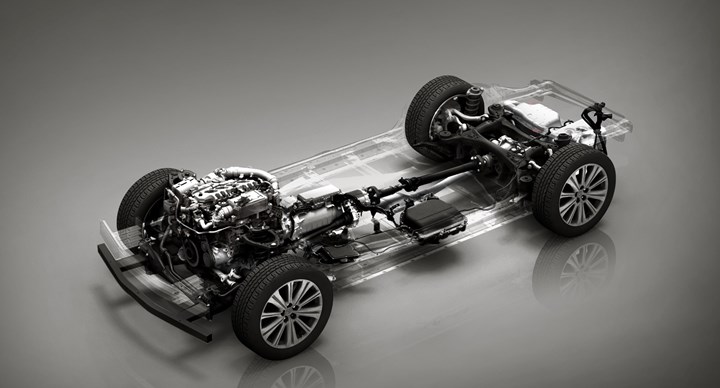
Yes, Mazda offer diesel powertrains. (Not in the U.S., though). (Image: Mazda)
Let’s say for the sake of argument that when it comes to passenger vehicles—as distinct from commercial vehicles—diesels have had their day.
Mazda will putting a newly developed diesel in the CX-60 for markets like the U.K. in 2023. So that argument evidently doesn’t hold. (And don’t forget those aforementioned Amarok diesels.)
The 3.3-liter in-line six e-Skyactiv D engine features what is called “Distribution-Controlled Partially Premixed Compression Ignition” (DCPCI), technology that helps the engine achieve a thermal efficiency of >40%.
DCPCI is said to contribute to both fuel efficiency and low emissions.
There are two variants of the engine:
- The AWD CX-60 gets a 250-hp version of the diesel. It has a fuel economy (on the WLTP cycle) of 53.3 mpg and produces CO2 at a rate of 137 g/km.
- The RWD has a 197-hp diesel. Its numbers are 57.6 mpg and 127 g/km.
Somehow those emissions numbers don’t seem all that astonishing, as it says in “Green Paper on a New Road Vehicle CO2 Emissions Regulatory Framework for the United Kingdom,” presented to Parliament by the Secretary of State for Transport by Command of Her Majesty:
“In 2020, a fleet-wide average emissions target of 95g CO₂/km applied to the entirety of the EU/Iceland/Norway/UK new car fleet, down from 130g CO₂/km in 2019.”
Perhaps the plug-in hybrid version of the CX-60 helps with averaging.
Another curious thing:
The Society of Motor Manufacturers and Traders (SMMT), the U.K. automotive trade association, has sales numbers for the first half of 2022 showing diesel sales in passenger cars are 46,028, down 50.6% from the first half of ’21.
Seems strange that an OEM would even think about a diesel, although the SMMT also has it that Mazda sold 3,447 vehicles in the first half of ’22 (down 58.92% from the previous year) so any product it can sell is certainly helpful to its efforts.
>>>
2022 Toyota Camry Hybrid XSE
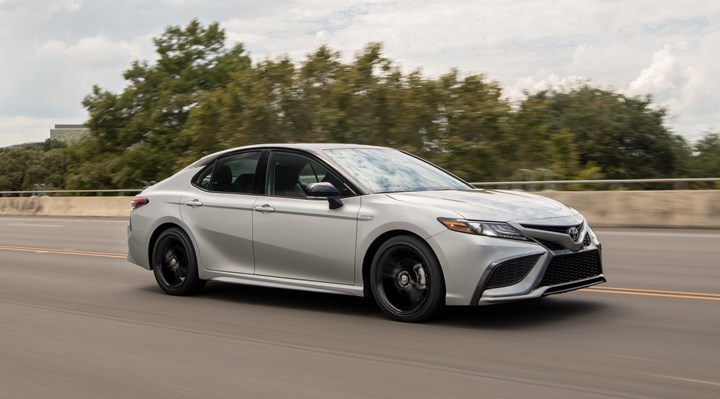
When people think about “hybrids,” how many do you think imagine something like this? (Image: Toyota)
Let’s start with some numbers that people generally end writeups like this with.
The base MSRP for the 2022 Toyota Camry Hybrid XSE is $32,820. Then there is a $1,025 delivery processing and handling fee.
That’s $33,845.
The vehicle as-driven has various options. The most-expensive, $1,760, is the Navigation Package, which includes a 9-inch touchscreen, a navigation system, nine JBL speakers, Apple CarPlay and Android Auto compatibility. There is a nice two-tone paint package—Midnight Black Metallic Roof, rear spoiler and mirror caps and a Supersonic Red body—that added only $500. There were other things that brought the total MSRP to $38,369.
Or roughly $10K less than the current average transaction price for all vehicles.
And then there is this number:
46.
That is the U.S. EPA-estimated combined (city/highway) number for miles per gallon returned by the Camry Hybrid XSE.
(For those opting for the lower trim model, know that number is 52 mpg. There is something to be said for thrift.)
More numbers, in the form of dimensions:
- 192.7 inches long
- 72.4 inches wide
- 56.9 inches high
- 99.9 cubic feet of passenger volume (seats five)
- 15.1 cubic feet of cargo volume
Then there is the seemingly obligatory output number:
- 208 hp from the system: 176 from the 2.5-liter engine and 118 from the permanent magnet synchronous motor
And while in the powertrain space:
- 87 octane (or higher) is the type of fuel necessary (a.k.a., “regular”)
This is an excellent family car even if the family consists of one person.
It is stylish. It is efficient. And while you’re not going to necessarily beat anyone from a dead stop when the light turns green, it performs as a midsize family car should, which means that you’re not going to squirm when merging onto a freeway.
Another number:
- 607
That’s the total range the EPA estimates the vehicle can deliver.
Which means you could travel from Detroit to Traverse City and back (510.8 miles) or from Detroit to Chicago round trip (565.6 miles) without visiting a gas station.
That, in my estimation, is the real beauty of a hybrid compared to EVs as they currently exist.
Gasoline has a far higher energy density than lithium-ion batteries, and while an electric motor is far more efficient in transforming its energy to work (a lot of the energy from a gallon of gas is nothing more than waste heat), the hybrid has the benefits of all of the above.
While some say that the hybrid is too complicated and expensive, (1) the complication is not there for the consumer, just the manufacturer; (2) the price of the Camry Hybrid, for it being a reliable car with an array of amenities (yes, yes, Toyota Safety Sense 2.5+, leather front seats, etc.) doesn’t seem out of line.
A final number:
- 2,750
That’s the number of dollars that someone would save in fuel costs over five years compared to the average new vehicle according to the U.S. EPA (it is one of the numbers on the window sticker)—and that calculation is predicated on driving 15,000 per year and gasoline at $2.35 per gallon.
Remember prices like that?
>>>
How Mercedes Had a Good Q2
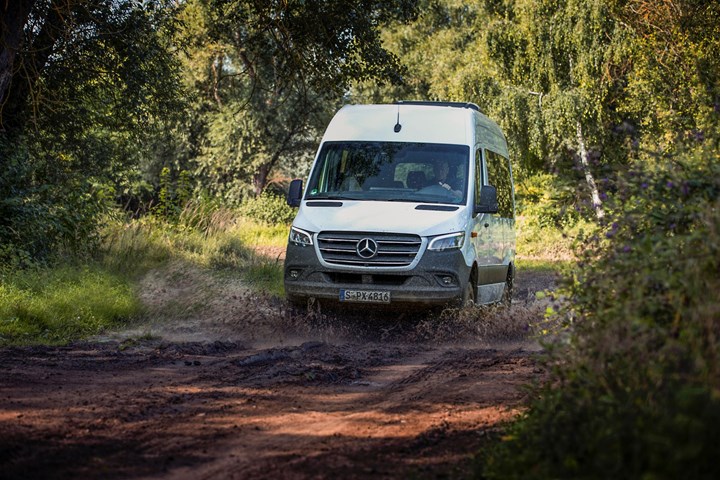
The Mercedes Sprinter. A van. (Image: Mercedes-Benz)
And to return to the company that this opened with. . .
Mercedes-Benz U.S. Q2 numbers came out this week and so missed last week’s look at some of the sales of other OEMs, but there is something there that is fascinating. (Or so I think.)
First know that compared with Q2 2021, MBUSA was up 6.9%.*
Consider:
Mercedes has these vehicles on offer in the U.S.:
A-Class, CLA, C-Class, E-Class/CLS, S-Class, AMG GT, GLA, GLB, GLC, GLE, GLS, G-Class, EQS-Sedan.
And Vans.
Of all of those vehicles, only the following didn’t have minus signs in front of their Q2 ’22 performance: A-Class, S-Class, GLC, EQS.
And Vans.
Overall, there were 98,835 vehicles sold in Q2 ’22 compared with 92,443 in Q2 ’21.
One big contributor to the increase is the electric EQS: there were 1,959 sold in Q2 ’22. There were 0 sold in Q2 ’21.
The S-Class (starting at $112,150, but if you have to ask. . . .) had Q2 ’22 sales of 3,920, or a 950.9% gain over Q2 ’21, when 373 were sold.
Underlining the popularity of midsize SUVs, the GLC sales, at 19,149, were 4,569 units higher than in Q2 ’21. And even the A-Class added 281 units to the good side of the ledger, with overall Q2 ’22 sales of 2,905, 10.7% over the same period in ’21.
And Vans.
Yes, vans were a sweet spot for MBUSA.
There were 19,730 Vans sold in Q2 ’22, 9,677 more than in ‘Q2 ’21.
Or, while the A-Class, S-Class, GLC and EQS combined were 10,356 to the plus side, the Vans alone were just some 7% below that figure.
Mercedes-Benz. Vans.
==
*For the first half of 2022 MBUSA is down 4.2% compared with the same period in ‘21.
RELATED CONTENT
-
Jeeps Modified for Moab
On Easter morning in Moab, Utah, when the population of that exceedingly-hard-to-get-to town in one of the most beautiful settings on Earth has more than doubled, some people won’t be hunting for Easter eggs, but will be trying to get a good look at one of the vehicles six that Jeep has prepared for real-life, fast-feedback from the assembled at the annual Easter Jeep Safari.
-
On Fuel Cells, Battery Enclosures, and Lucid Air
A skateboard for fuel cells, building a better battery enclosure, what ADAS does, a big engine for boats, the curious case of lean production, what drivers think, and why Lucid is remarkable
-
Multiple Choices for Light, High-Performance Chassis
How carbon fiber is utilized is as different as the vehicles on which it is used. From full carbon tubs to partial panels to welded steel tube sandwich structures, the only limitation is imagination.


.jpg;width=70;height=70;mode=crop)






